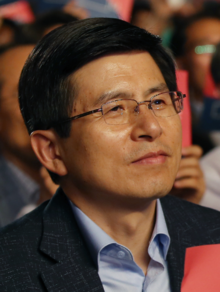Prime minister of South Korea
| Prime Minister of the Republic of Korea 국무총리 / 國務總理 |
|
|---|---|

Prime ministerial standard
|
|

Prime ministerial emblem
|
|
| Style | His/Her Excellency (각하) |
| Appointer |
President of South Korea (with the National Assembly's approval) |
| Term length | No fixed term |
| Inaugural holder | Lee Beom-seok |
| Formation | 31 July 1948 |
| Website |
(English) pmo.go.kr/ (Korean) pmo.go.kr/ |
| Prime Minister of South Korea | |
| Hangul | 국무총리 |
|---|---|
| Hanja | 國務總理 |
| Revised Romanization | Gungmuchongni |
| McCune–Reischauer | Kungmuch'ongni |
The Prime Minister of the Republic of Korea (국무총리 / 國務總理, Gungmuchongni) is appointed by the President of South Korea, with the National Assembly's approval. The officeholder is not required to be a member of the National Assembly. The Prime Minister is not the head of government but rather serves in a role similar to that of a vice-president.
The Sino-Korean word gungmu (국무/國務) means "state affairs" and chongni (총리/總理) means "prime minister", "premier" or "chancellor", so the full title in Korean means literally "Prime Minister for State Affairs", but it is not used as official English title. The short title in Korean is just Chongni.
The position was created on 31 July 1948, two weeks before the government of South Korea was founded, and was held by Lee Beom-seok until 1950. The title was Chief Cabinet Minister from 1961 until 1963.
On 27 April 2014, Prime Minister Chung Hong-won announced his desire to resign. However, due to unsuccessful nominations, Chung remained in office until February 2015.
On 23 January 2015, President Park Geun-hye named Saenuri's Floor Leader Lee Wan-koo as the new prime minister. Lee was confirmed by the National Assembly as prime minister on 16 February 2015. However, on April 20 of the same year, he offered his resignation to the President in the midst of a bribery scandal.
The prime minister is the principal executive assistant to the president, who is the actual head of government, not the prime minister. The prime minister holds the second position after the president in the State Council of South Korea, which is the cabinet. The prime minister assists the head of state by supervising ministries, make recommendations for ministers, and is the vice chairman of the Cabinet. The Prime Minister is the first in the order of succession to discharge the duties of the office of the President as the Acting President should the president be unable to discharge her or his office. The most recent person to have served as Acting President has been Hwang Kyo-ahn during the impeachment trial of President Park Geun-hye in 2016.
...
Wikipedia

